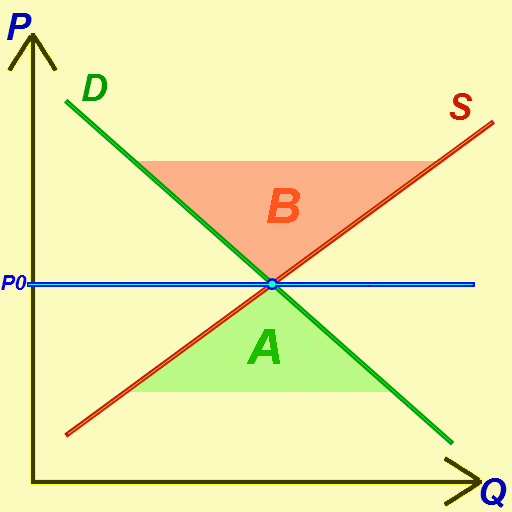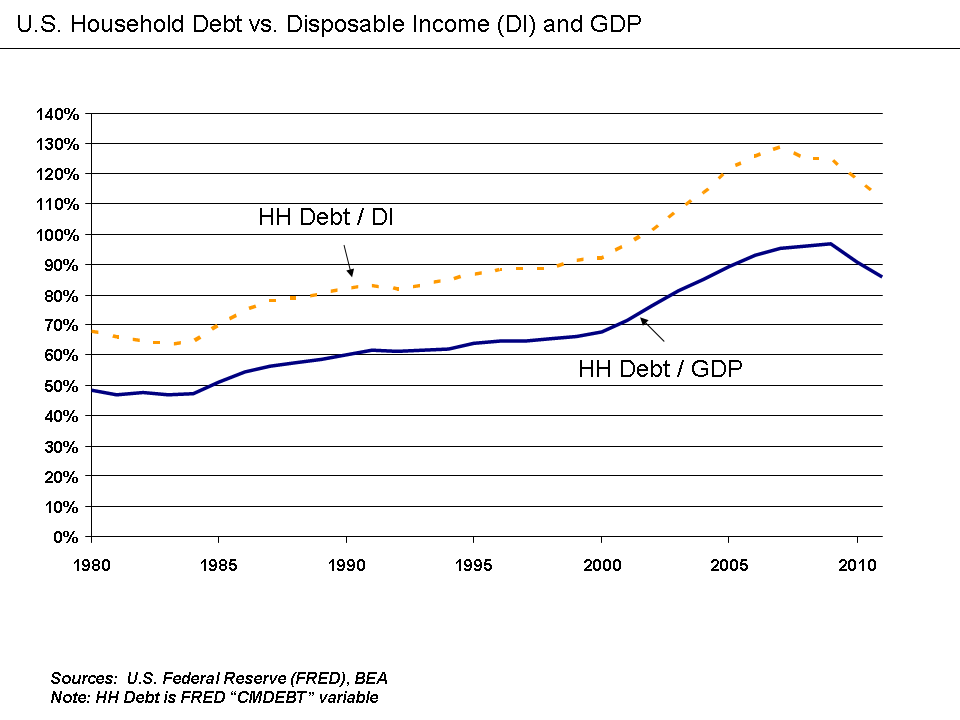|
Debt Deflation
Debt deflation is a theory that recessions and depressions are due to the overall level of debt rising in real value because of deflation, causing people to default on their consumer loans and mortgages. Bank assets fall because of the defaults and because the value of their collateral falls, leading to a surge in bank insolvencies, a reduction in lending and by extension, a reduction in spending. The theory was developed by Irving Fisher following the Wall Street Crash of 1929 and the ensuing Great Depression. The debt deflation theory was familiar to John Maynard Keynes prior to Fisher's discussion of it, but he found it lacking in comparison to what would become his theory of liquidity preference. The theory, however, has enjoyed a resurgence of interest since the 1980s, both in mainstream economics and in the heterodox school of post-Keynesian economics, and has subsequently been developed by such post-Keynesian economists as Hyman Minsky and by the neo-classical mainstre ... [...More Info...] [...Related Items...] OR: [Wikipedia] [Google] [Baidu] |
Recession
In economics, a recession is a business cycle contraction when there is a general decline in economic activity. Recessions generally occur when there is a widespread drop in spending (an adverse demand shock). This may be triggered by various events, such as a financial crisis, an external trade shock, an adverse supply shock, the bursting of an economic bubble, or a large-scale anthropogenic or natural disaster (e.g. a pandemic). In the United States, a recession is defined as "a significant decline in economic activity spread across the market, lasting more than a few months, normally visible in real GDP, real income, employment, industrial production, and wholesale-retail sales." The European Union has adopted a similar definition. In the United Kingdom, a recession is defined as negative economic growth for two consecutive quarters. Governments usually respond to recessions by adopting expansionary macroeconomic policies, such as increasing money supply and decreasing int ... [...More Info...] [...Related Items...] OR: [Wikipedia] [Google] [Baidu] |
The Great Crash, 1929
''The Great Crash, 1929'' is a book written by John Kenneth Galbraith and published in 1955. It is an economic history of the lead-up to the Wall Street Crash of 1929. The book argues that the 1929 stock market crash was precipitated by rampant speculation in the stock market, that the common denominator of all speculative episodes is the belief of participants that they can become rich without work and that the tendency towards recurrent speculative orgy serves no useful purpose, but rather is deeply damaging to an economy.Galbraith, p19 It was Galbraith's belief that a good knowledge of what happened in 1929 was the best safeguard against its recurrence. The idea for the book Galbraith wrote the book during a break from working on the manuscript of what would become ''The Affluent Society''. Galbraith was asked by Arthur M. Schlesinger Jr. if he would write the definitive work on the Great Depression that he would then use as a reference source for his own intended work on R ... [...More Info...] [...Related Items...] OR: [Wikipedia] [Google] [Baidu] |
Debt Relief
Debt relief or debt cancellation is the partial or total forgiveness of debt, or the slowing or stopping of debt growth, owed by individuals, corporations, or nations. From antiquity through the 19th century, it refers to domestic debts, in particular agricultural debts and freeing of debt slaves. In World War I the United States Treasury made large loans to the allies that were postponed, reduced and finally paid off in 1953. In the late 20th century, it came to refer primarily to Third World debt, which started exploding with the Latin American debt crisis (Mexico 1983, etc.). In the early 21st century, it is of increased applicability to individuals in developed countries, due to credit bubbles and housing bubbles. International debt relief First World War reparations War debt payments by World War I Allies to the U.S. had been suspended in 1931—only Finland paid in full—and American public opinion demanded repayments resume as a condition of U.S. postwar aid. Germany ha ... [...More Info...] [...Related Items...] OR: [Wikipedia] [Google] [Baidu] |
Economic Equilibrium
In economics, economic equilibrium is a situation in which economic forces such as supply and demand are balanced and in the absence of external influences the ( equilibrium) values of economic variables will not change. For example, in the standard text perfect competition, equilibrium occurs at the point at which quantity demanded and quantity supplied are equal. Market equilibrium in this case is a condition where a market price is established through competition such that the amount of goods or services sought by buyers is equal to the amount of goods or services produced by sellers. This price is often called the competitive price or market clearing price and will tend not to change unless demand or supply changes, and quantity is called the "competitive quantity" or market clearing quantity. But the concept of ''equilibrium'' in economics also applies to imperfectly competitive markets, where it takes the form of a Nash equilibrium. Understanding economic equilib ... [...More Info...] [...Related Items...] OR: [Wikipedia] [Google] [Baidu] |
Reflation
Reflation is used to describe a return of prices to a previous rate of inflation. One usage describes an act of stimulating the economy by increasing the money supply or by reducing taxes, seeking to bring the economy (specifically the price level) back ''up'' to the long-term trend, following a dip in the business cycle. It is the opposite of disinflation, which seeks to return the economy back ''down'' to the long-term trend. Overview In this perspective, reflation, is contrasted with inflation (narrowly speaking) ''above'' the some long-term trend line, while reflation is a recovery of the price level when it has fallen ''below'' the trend line. For example, if inflation had been running at a 3% rate, but for one year it falls to 0%, the following year would need 6% inflation (actually 6.09% due to compounding) to catch back up to the long-term trend. This higher than normal inflation is considered reflation, since it is a return to trend, not exceeding the long-term trend. Th ... [...More Info...] [...Related Items...] OR: [Wikipedia] [Google] [Baidu] |
Financial Instability Hypothesis
Hyman Philip Minsky (September 23, 1919 – October 24, 1996) was an American economist, a professor of economics at Washington University in St. Louis, and a distinguished scholar at the Levy Economics Institute of Bard College. His research attempted to provide an understanding and explanation of the characteristics of financial crises, which he attributed to swings in a potentially fragile financial system. Minsky is sometimes described as a post-Keynesian economist because, in the Keynesian tradition, he supported some government intervention in financial markets, opposed some of the financial deregulation of the 1980s, stressed the importance of the Federal Reserve as a lender of last resort and argued against the over-accumulation of private debt in the financial markets. Minsky's economic theories were largely ignored for decades, until the subprime mortgage crisis of 2008 caused a renewed interest in them. Education A native of Chicago, Illinois, Minsky was born into ... [...More Info...] [...Related Items...] OR: [Wikipedia] [Google] [Baidu] |
Post-Keynesian Economics
Post-Keynesian economics is a school of economic thought with its origins in '' The General Theory'' of John Maynard Keynes, with subsequent development influenced to a large degree by Michał Kalecki, Joan Robinson, Nicholas Kaldor, Sidney Weintraub, Paul Davidson, Piero Sraffa and Jan Kregel. Historian Robert Skidelsky argues that the post-Keynesian school has remained closest to the spirit of Keynes' original work. It is a heterodox approach to economics. Introduction The term "post-Keynesian" was first used to refer to a distinct school of economic thought by Eichner and Kregel (1975) and by the establishment of the ''Journal of Post Keynesian Economics'' in 1978. Prior to 1975, and occasionally in more recent work, ''post-Keynesian'' could simply mean economics carried out after 1936, the date of Keynes's ''General Theory''. Post-Keynesian economists are united in maintaining that Keynes' theory is seriously misrepresented by the two other principal Keynesian scho ... [...More Info...] [...Related Items...] OR: [Wikipedia] [Google] [Baidu] |
Credit Crunch
A credit crunch (also known as a credit squeeze, credit tightening or credit crisis) is a sudden reduction in the general availability of loans (or credit) or a sudden tightening of the conditions required to obtain a loan from banks. A credit crunch generally involves a reduction in the availability of credit independent of a rise in official interest rates. In such situations, the relationship between credit availability and interest rates changes. Credit becomes less available at any given official interest rate, or there ceases to be a clear relationship between interest rates and credit availability (i.e. credit rationing occurs). Many times, a credit crunch is accompanied by a flight to quality by lenders and investors, as they seek less risky investments (often at the expense of small to medium size enterprises). Causes A credit crunch is often caused by a sustained period of careless and inappropriate lending which results in losses for lending institutions and investor ... [...More Info...] [...Related Items...] OR: [Wikipedia] [Google] [Baidu] |
Aggregate Demand
In macroeconomics, aggregate demand (AD) or domestic final demand (DFD) is the total demand for final goods and services in an economy at a given time. It is often called effective demand, though at other times this term is distinguished. This is the demand for the gross domestic product of a country. It specifies the amount of goods and services that will be purchased at all possible price levels. Consumer spending, investment, corporate and government expenditure, and net exports make up the aggregate demand. The aggregate demand curve is plotted with real output on the horizontal axis and the price level on the vertical axis. While it is theorized to be downward sloping, the Sonnenschein–Mantel–Debreu results show that the slope of the curve cannot be mathematically derived from assumptions about individual rational behavior. Instead, the downward sloping aggregate demand curve is derived with the help of three macroeconomic assumptions about the functioning of markets ... [...More Info...] [...Related Items...] OR: [Wikipedia] [Google] [Baidu] |
Anna Schwartz
Anna Jacobson Schwartz (pronounced ; November 11, 1915 – June 21, 2012) was an American economist who worked at the National Bureau of Economic Research in New York City and a writer for ''The New York Times''. Paul Krugman has said that Schwartz is "one of the world's greatest monetary scholars." ">/sup> Schwartz collaborated with Nobel laureate Milton Friedman on ''A Monetary History of the United States, 1867–1960'', which was published in 1963. ">/sup> This book placed the blame for the Great Depression at the door of the Federal Reserve System. Robert J. Shiller describes the book as the "most influential account" of the Great Depression. She was also president of the Western Economic Association International in 1988. ">/sup> Schwartz was inducted into the National Women's Hall of Fame in 2013. Early life and education Schwartz was born Anna Jacobson on November 11, 1915, in New York City to Pauline (''née'' Shainmark) and Hillel Jacobson. She graduated Phi ... [...More Info...] [...Related Items...] OR: [Wikipedia] [Google] [Baidu] |
Milton Friedman
Milton Friedman (; July 31, 1912 – November 16, 2006) was an American economist and statistician who received the 1976 Nobel Memorial Prize in Economic Sciences for his research on consumption analysis, monetary history and theory and the complexity of stabilization policy. With George Stigler and others, Friedman was among the intellectual leaders of the Chicago school of economics, a neoclassical school of economic thought associated with the work of the faculty at the University of Chicago that rejected Keynesianism in favor of monetarism until the mid-1970s, when it turned to new classical macroeconomics heavily based on the concept of rational expectations. Several students, young professors and academics who were recruited or mentored by Friedman at Chicago went on to become leading economists, including Gary Becker, Robert Fogel, Thomas Sowell and Robert Lucas Jr. Friedman's challenges to what he called "naive Keynesian theory" began with his interpretatio ... [...More Info...] [...Related Items...] OR: [Wikipedia] [Google] [Baidu] |




